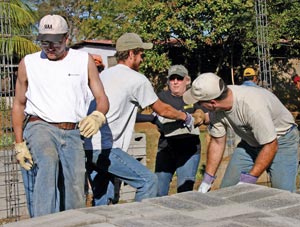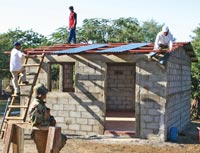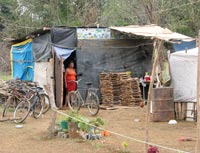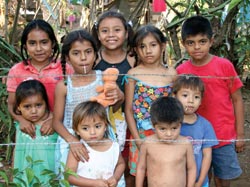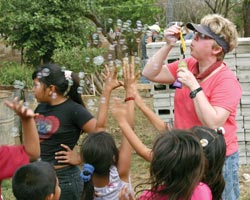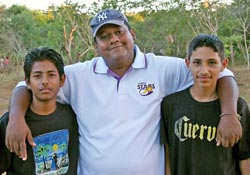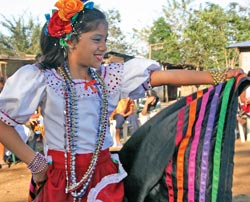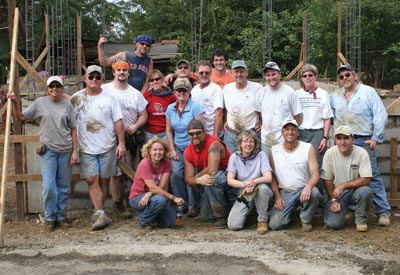Building dreams, changing lives Agents bring hope to a Nicaraguan village…And take home gifts of gratitude and humility By Elisabeth Boone, CPCU On February 5, 2006, a group of 17 members and friends of The Sitkins 100™ flew to Nicaragua to spend a week building houses in the rural village of Los Lopez. Half the group members were “sophomores,” having traveled to the region in January 2005 for the same purpose. (See “The House that Agents Built” in the April 2005 issue of Rough Notes.) The other half were seeing the ravaged beauty of rural Nicaragua for the first time. The commitment was born in the fall of ’04, when Mark Rollins, president of The Rollins Agency in Tuckahoe, New York, told fellow members of The Sitkins Group about a trip he had taken to Nicaragua the previous year to build simple cement block houses for people in a poor rural village. Mark’s trip was conducted under the auspices of an organization called Bridges to Community, whose mission is marshaling First World resources to meet Third World needs. Bridges operates community development projects in Nicaragua, Kenya, and Cambodia, bringing together groups of American volunteers and local residents to build safe shelter and create the hope of a better life. The organization’s goal is to provide a culturally enriching adventure for both volunteers and villagers by encouraging them to discover their similarities instead of focusing on their differences.
Mark presented the story of his own Nicaragua building experience at a Sitkins Extreme Networking™ event. Working side by side with Bridges’ permanent crew of masons, Mark’s group, the Westchester Business Leaders, built simple, sturdy houses for families who had been living in shacks. The families had spent years on the waiting list. Looking at his fellow agents at The Sitkins Group meeting, Mark issued a challenge and made a promise: “Come with us to Nicaragua. This experience changed my life, and I promise it will change yours.” Building bridges Guiding and supporting each volunteer group are Bonnie and Jim Gordon, American citizens who represent Bridges to Community in Masaya, a small city that’s the hub for several outlying rural villages. Jim and Bonnie are at the center of a laughing, chattering circle wherever they go. Adored by the kids and admired and respected by adults, the couple’s lives are inextricably intertwined with the people of the villages in which they work. Rounding out the Bridges team are David Sandino, a native Masayan who serves as the official translator, and Tim Esser-Haines, a young friend of Bonnie and Jim’s from Philadelphia who has clearly found his passion in this place of need and hope. David attended high school in Los Angeles and speaks fluent English. He helps volunteers and villagers transcend the language barrier and enjoy lively conversations. Also bilingual, Tim lives in Masaya with three young Nicaraguan men who work and attend school. Bonnie and Jim have high praise for Tim’s outreach to teenagers who otherwise might be lost to the drugs, crime, and violence that cut so many young lives short.
Meeting our families After settling in the dormitory in the Bridges compound in Las Conchitas—which features cement block walls and rows of metal cots festooned in mosquito netting—we board our bus for the 15-minute ride to Los Lopez, where our group will help build two houses and lay the foundation for a third. All along the dusty, deeply rutted road, we’re greeted by knots of beaming villagers. Walking, biking, on horseback, in oxen carts and battered vehicles, everyone from infants to grandparents turns out to offer a joyous welcome to los gringos. We reach Los Lopez. “It’s beautiful here!” someone in our group exclaims, looking out on a smooth green expanse of land basking in the afternoon sun, edged by small groves of old trees under which we see people, animals, livestock pens, outdoor kitchens, the occasional well-used car or truck. Closer up, however, we come face to face with the reason we’re here: a cluster of tiny, cramped shacks. A dwelling fashioned of broken boards, scraps of galvanized metal, and sheets of black plastic may be home to eight or more members of a family. In this region of earthquakes and long rainy seasons, these shacks provide minimal shelter, and many simply collapse in a storm. The houses that Bridges builds are designed to meet the basic requirements of safe shelter. Measur-ing 13 by 15 feet, each house is constructed of cement block reinforced by rebar, and features window openings with shutters, a red tile floor, a galvanized metal roof, and a solid, sturdy door. The cost to build a house is $3,500. Several members of our group have contributed that amount. Letting go Terry Flood of The Flood Group in Flushing, New York, an agency owner and father of three, hesitantly approaches his adopted family and scans their faces. He extends his hand to offer a gift: a framed photograph of his family—and in the taut expectant hush, tears streak down his cheeks. “That did it,” Terry tells the group that night when we gather with the Bridges team to reflect on the day’s experiences. “I have a family, they have a family, and that’s all that mattered.” Terry’s colleague from The Flood Group, Dennis Kelly, echoed that sentiment: “We’re all just people, only the circumstances are different.”
A roll of the dice This trip is the first for Heather Dougherty of The Flanders Group in Pittsford, New York. Heather, a mother of three young children, shares with the group the sense of outrage. “It’s so unfair,” she says. “Why do we have everything and they have nothing?” “No one promised us that life would be fair,” says Patricia Clevenger of Stoltz & Company in Midland, Texas, a returning veteran from last year’s trip. “The most tremendous thing here is the appreciation people feel for what we’re doing. I don’t feel tears; I feel joy and laughter.” Offering another perspective is Tom Fliege of Hawk Insurance in Peoria, Illinois. “My motto is: Never argue with the dealer,” he says. “All day I wonder: What’s expected of me beyond building houses? I’ve seen this kind of poverty before, but this is the first time I’ve tried to do something about it. I’m not here by accident.” Neither are Kim Findlay of Trissell, Graham & Toole in Davenport, Iowa, and her husband Rick, a landscape designer. “I’ve been looking for a purpose,” Rick says, “and I’m finding it here.” “It’s a blessing to have the opportunity to be here,” Kim tells the group. “The U.S. is not seen favorably in much of the world, but individuals can make a difference.” At the job site, everyone is warmed by the sight of Kim at the center of a cluster of excited kids, eagerly chasing the cascades of bubbles that stream from the bubble pipe she’s brought with her.
Erica Martinson of The Rollins Agency is another veteran of the 2005 trip. Like other second-timers, she observes, she doesn’t face the adjustments that seemed overwhelming last year: living in a coed dorm, taking bucket showers, trekking up the hill to the outhouse. “The externals aren’t a challenge,” she says. “Being back fits comfortably, like a second skin. In a way, it’s like I never left. I wonder: What will I learn this time about myself and others?” Roxana Sora of Seitlin Risk Management in Miami is a newcomer to the Bridges experience, but not to the challenges of the Third World. Roxie and her sister were sent to the United States from their native Cuba in the early 1960s as Fidel Castro was coming to power. After living in an Iowa orphanage for several months, Roxie and her sister had the good fortune to be reunited with their parents. Today Roxie and her husband accompany a group from their church on missions to the Dominican Republic. Roxie is a tireless bridge builder, engaging the villagers in lively conversation and helping volunteers transcend the language barrier. “The Lord gives us a lot and expects a lot from us,” she says. Fathers and sons
Last year’s group included one father and son team: Roger Sitkins and son Patrick, who were stalwarts at the construction site and, back at the compound, headed not for the showers but for the baseball field. Each afternoon Roger, Patrick, and other members of the group engaged the local young men in a lively game of beisbol that featured cheers, jeers, and a set of rules that seemed to be highly flexible depending on who was making the call. Joining Roger and Patrick this year were two additional father and son duos: Herb Moran and his son, Tommy, both of the San Francisco Insurance Center, and Roy Riley and his father, R.C., of Peel & Holland Financial Group in Benton, Kentucky. First-timer Tommy Moran’s observes, “I’ve never seen an insincere smile all day. I wish we could take that back with us. I’m getting more out of this experience than I’m able to give.” His father, Herb, adds, “I find it hard to live one day at a time. Coming here has enabled me to look at my life in a much different way, in a way that’s more humbling and more fulfilling.” R.C. Riley was delighted to join his son, Roy, a veteran of last year’s trip, for this year’s experience. “I’ve struggled all my life with the question of what’s fair. Here, I’m learning to put the fairness issue aside. I see how important it is to change one person’s life at a time.” Roger Sitkins adds, “Coming back has opened my eyes again. It’s amazing to me that people from all over the U.S., from all different backgrounds, have come here together to help.” The work is never done Our week speeds by. Each day we rise early, take the bumpy ride to the work site, and work on these simple houses with the local men on the permanent construction crew. In the evening we return to the compound—hot, sweaty, tired, carrying in our muscles and our minds the solid feeling of accomplishment for which we often struggle back at home.
On Saturday afternoon, fresh from a day in the lovely Spanish colonial city of Granada, we return to Los Lopez, where the villagers have arranged a festivity to celebrate their new homes and thank us for our help. We sit in the chairs they’ve placed in a circle and sip from the cans of cold soda offered to us by the local ladies. We’re dazzled by a series of native dances performed by brightly costumed children and delighted by a fierce contest among the kids to pierce the candy-filled bellies of two huge papier maché piñatas. One by one, the families for whom we’ve helped to build houses come forward. Shyly, they offer small gifts of thanks. With David translating, they share their words of gratitude and their prayers for us, our families, and our safe journey home. We’re all taken by surprise when a local leader asks Mark and Roger to join him in the center of our circle. He presents a gift: a beautifully executed oil painting, in a charming primitive style, of the construction site at Los Lopez, showing each member of our group engaged in a task. In the top right hand corner, in careful lettering, we see each of our names. The goodbyes aren’t easy. Then it’s just us—los Americanos—boarding our bus and riding away from the village. On the bus, there’s a deep, reflective silence. Slowly, hesitantly, quiet conversations begin. *
|
||||||||||||||||||||||
|



